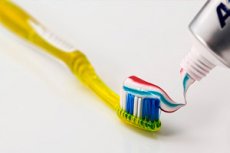New publications
Which is better for teeth: fluoride or hydroxyapatite?
Last reviewed: 29.06.2025

All iLive content is medically reviewed or fact checked to ensure as much factual accuracy as possible.
We have strict sourcing guidelines and only link to reputable media sites, academic research institutions and, whenever possible, medically peer reviewed studies. Note that the numbers in parentheses ([1], [2], etc.) are clickable links to these studies.
If you feel that any of our content is inaccurate, out-of-date, or otherwise questionable, please select it and press Ctrl + Enter.

Teeth cleaning products containing hydroxyapatite do just as good a job as the well-known fluoride toothpastes. Both fluoride and hydroxyapatite are equally effective with regular oral care.
A new study on this topic was conducted by representatives of the Polish Adam Mickiewicz University (Poznan).
As a standard practice, dentists recommend toothpastes for daily use that contain fluorides - fluoride compounds that can effectively prevent damage to tooth enamel. However, it is known that such toothpastes can not always be used, which depends on the composition of drinking water and food consumed, as well as on what additional oral care products a person uses. Large amounts of fluoride can provoke the development of dental fluorosis or other side effects. For this reason, the fluoride content of toothbrushes is always strictly regulated, and fluoride toothpastes are not recommended at all for infants and preschool children.
In a number of studies, scientists have proven that fluoride-free hydroxyapatite dental products are equally effective in preventing tooth decay, including in children and adolescents. Hydroxyapatite is a calcium-phosphate mineral found in human bone tissue and teeth. Studies have demonstrated that hydroxyapatite-based products create favorable conditions for remineralization of the enamel layer and dentin, and prevent demineralization of hard dental tissues. The work of scientists was aimed at evaluating the preventive abilities of hydroxyapatite pastes, compared to fluoride-containing products for adults.
Researchers conducted a year-and-a-half randomized, double-blind clinical trial involving more than 170 adult patients between the ages of 18 and 45. The participants were divided into two groups, the first of which brushed their teeth with hydroxyapatite products and the second with fluoride toothpastes. Each of the participants had some pre-existing dental problems, but at least a dozen of each patient's teeth were healthy. All participants used electric toothbrushes.
Teeth were brushed strictly twice a day, after meals, for three minutes. Specialists observed that the participants' dietary intake did not change and no additional oral care products were used.
Throughout the study, regular dental checkups were performed on patients from the two groups. At the end of the experiment, it was found that caries progression was absent in 89% of people who brushed with hydroxyapatite toothpastes and in 87% of people who used fluoride toothpastes. In other words, both the first and second remedies showed almost equal effectiveness.
Information can be found at frontiersintitle="Frontiers | Caries-preventing effect of a hydroxyapatite-toothpaste in adults: a 18-month double-blinded randomized clinical trial">
